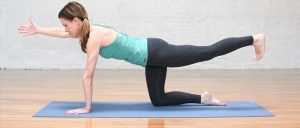Yoga Poses That Actually Help Relieve Chronic Lower Back Pain
Chronic lower back pain affects millions worldwide, limiting mobility and impacting quality of life. While medications and physical therapy help, yoga has emerged as a powerful, natural way to relieve discomfort and strengthen the muscles supporting the spine. Practicing the right yoga poses improves flexibility, reduces tension, and promotes proper posture. In this guide, we’ll explore yoga poses that actually help relieve chronic lower back pain and offer tips for safe practice.

Why Yoga Helps Lower Back Pain
Yoga combines stretching, strengthening, and mindful movement, making it effective for lower back health. Here’s why it works:
1. Increases Flexibility
Tight hamstrings, hip flexors, and back muscles often contribute to lower back pain. Yoga gently stretches these areas, reducing strain on the spine.
2. Strengthens Core Muscles
A strong core provides essential support for the lumbar region. Many yoga poses engage deep abdominal and back muscles, stabilizing the spine.
3. Promotes Proper Alignment
Yoga encourages awareness of posture and body alignment, helping to prevent harmful habits that exacerbate lower back pain.
4. Reduces Stress and Muscle Tension
Chronic stress often leads to muscle tightness in the back and hips. Yoga’s breathing and relaxation techniques relieve tension and improve circulation.
Top Yoga Poses for Lower Back Pain Relief
The following poses are safe for most individuals with chronic lower back pain. Always consult a healthcare professional before starting a new exercise routine, and move gently into each posture.
1. Cat-Cow Pose (Marjaryasana-Bitilasana)
This gentle flow warms up the spine and relieves stiffness.
- How to Do It: Start on hands and knees with wrists under shoulders and knees under hips. Inhale, arch your back and lift your head and tailbone (Cow). Exhale, round your spine and tuck your chin (Cat). Repeat for 5–10 breaths.
- Benefits: Increases spinal flexibility, relieves tension, and improves circulation in the lower back.
2. Child’s Pose (Balasana)
A restorative pose that gently stretches the lower back and hips.
- How to Do It: Kneel on the mat, sit back on your heels, and fold forward with arms extended in front. Rest your forehead on the mat and breathe deeply.
- Benefits: Stretches the spine, reduces tension in the lower back, and calms the nervous system.
3. Downward-Facing Dog (Adho Mukha Svanasana)
This pose lengthens the spine and stretches the hamstrings and calves.
- How to Do It: From hands and knees, lift your hips toward the ceiling, forming an inverted V-shape. Keep knees slightly bent if hamstrings are tight and press heels toward the floor.
- Benefits: Relieves tension in the lower back, strengthens shoulders, and stretches hamstrings and calves.
4. Sphinx Pose (Salamba Bhujangasana)
A gentle backbend that strengthens the lower back without overextension.
- How to Do It: Lie on your stomach, elbows under shoulders, forearms on the floor. Press forearms down and lift your chest gently, keeping the pelvis grounded.
- Benefits: Strengthens the spine, opens the chest, and improves posture.
5. Supine Twist (Supta Matsyendrasana)
Releases tension in the lower back and improves spinal mobility.
- How to Do It: Lie on your back, bend knees, and let them fall to one side while keeping shoulders grounded. Extend arms out to a T-shape and turn your head in the opposite direction. Hold 20–30 seconds per side.
- Benefits: Stretches the spine and back muscles, relieves tight hips, and improves digestion and circulation.
6. Pigeon Pose (Eka Pada Rajakapotasana)
Targets the hips, which are often tight in people with lower back pain.
- How to Do It: From downward dog, bring one knee forward and place it behind your hands, foot angled slightly outward. Extend the other leg back and fold forward gently.
- Benefits: Opens the hips, relieves lower back tension, and improves flexibility in the hip flexors and glutes.
7. Bridge Pose (Setu Bandhasana)
Strengthens glutes, lower back, and core muscles, providing support for the spine.
- How to Do It: Lie on your back with knees bent, feet hip-width apart. Press through your heels, lift hips, and clasp hands under your back if comfortable.
- Benefits: Strengthens posterior chain muscles, reduces back stiffness, and opens the chest.
Tips for Practicing Yoga Safely with Lower Back Pain
1. Move Slowly and Mindfully
Listen to your body and avoid forcing movements. Pain is a signal to adjust the pose or stop.
2. Use Props
Blocks, bolsters, or folded blankets can support the spine and make poses safer and more comfortable.
3. Focus on Breathing
Deep, steady breathing helps relax muscles, improves circulation, and reduces stress-related tension in the back.
4. Avoid Extreme Backbends
While gentle backbends are beneficial, deep or forced backbends can worsen lower back pain. Modify poses as needed.
5. Consistency is Key
Practicing yoga regularly—3–5 times per week—yields the best results for chronic lower back pain relief.
Conclusion
Yoga offers a natural, effective way to relieve chronic lower back pain while improving flexibility, strength, and posture. Poses like Cat-Cow, Child’s Pose, Downward Dog, Sphinx, Supine Twist, Pigeon, and Bridge target key muscles supporting the spine. By practicing safely, using props, and focusing on mindfulness and breathing, you can manage pain, prevent further injury, and enhance overall back health. Incorporate these poses into your routine to experience lasting relief and improved mobility.


